Helpful summary
-
Overview: This article focuses on optimizing the five key Scrum ceremonies to enhance software development project success, offering structured collaboration, planning, and reflection to improve efficiency and productivity.
-
Why Trust Us: With 87% of organizations relying on Scrum methodologies, many are looking for ways to streamline their ceremonies. Teaminal solves this problem by offering intuitive async meeting tools for Agile teams.
-
Why It Matters: Optimizing Scrum ceremonies is vital for enhancing productivity and work quality. The benefits are twofold—teams are more focused and efficient, and they achieve better project outcomes.
-
Action Points: Look into async tools like Teaminal to cut down on wasted time and win back hours each week. Also, be sure to reflect on your team’s Scrum ceremonies regularly to identify areas for improvement and ensure continued success.
-
Further Research: Check out our guide to optimizing your Agile workflow for more guidance.
Scrum ceremonies are vital for the success of software development projects. They provide a structured framework for teams to collaborate, plan, and reflect, promoting efficiency and productivity.
But (like any process) Scrum ceremonies can be optimized to improve their effectiveness.
How? That’s a question we’ve thought about quite a bit here at Teaminal. And in this article, we’ll be sharing our insights on how to make your Scrum ceremonies even better with the help of our all-in-one async Agile meeting tool.
Let’s get started.
Why listen to us?
At Teaminal, we’ve helped high-performing teams at companies like Angi, T-Mobile, and Workday optimize their Agile workflows and win back hours of development time.

We’ve seen first-hand how a well-executed Scrum ceremony can drive results and keep teams aligned towards their goals. And we’ve also seen the struggles teams face when these ceremonies are not optimized.
What are Scrum ceremonies?
Scrum ceremonies (also known as events or rituals) are key components of the Scrum framework.
These ceremonies often take the form of meetings—but as we’ll see in this article, that isn’t always best. They’re designed to give team members structure and to boost alignment with overarching product goals.
Here are the main Scrum ceremonies:
-
Backlog Grooming: This is an ongoing process where the Product Owner and the development team review and refine items in the backlog.
-
Sprint Planning: This is a ceremony held at the start of each sprint where the team determines what they can deliver and how they will achieve it.
-
Daily Scrum: This is a quick ceremony where the team discusses their goals for the day and any obstacles they’re facing.
-
Sprint Review: In this ceremony, the Scrum team and stakeholders review what was accomplished during the sprint and discuss what went well and what could be improved.
-
Sprint Retrospective: This ceremony is held at the end of each sprint to reflect on what went well, what didn’t, and how the team can improve in the next sprint.
So, why do these ceremonies become unoptimized? In our experience, it comes down to an overreliance on unnecessary face-to-face meetings.
The average developer spends 12.2 hours each month in meetings—many of which aren’t directly relevant to them. That constitutes quite a bit of waste in of itself, but you also need to think about the time wasted switching focuses between work and meetings throughout the day.
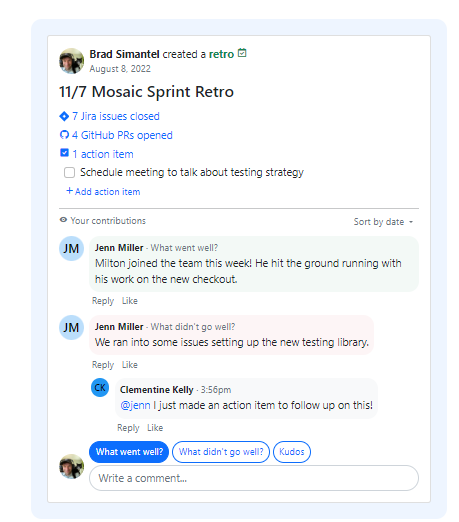
Teaminal is designed to optimize these Scrum ceremonies for distributed teams with a focus on async collaboration. Our tool integrates with Slack, so all communications and updates can be done in one place, eliminating the need for switching.
We also condense Scrum ceremonies into short, async check-ins and updates, allowing team members to focus on their work without being distracted by lengthy meetings.
Why is it important to optimize Scrum ceremonies?
Enhanced productivity
Earlier, we mentioned that the average developer spends 12.2 hours in meetings per month, and that this also led to wasted time when switching between tasks.
Well, this “switching cost” has been quantified—you decrease productivity by roughly 40% and efficiency by 80% for a period of time whenever you switch away from a task. This is supported by another study which recently found that a 40% reduction in meetings leads to an average productivity increase of 70%.
The bottom line? Meetings are costing you more time than you think.
Better quality of work
Less interruption means deeper focus and fewer mistakes.
Studies have shown that switching your focus between two tasks (say a meeting and a programming task) can result in an 80% decrease in focus. While some switching is unavoidable, it’s important to minimize it wherever possible.
That’s why async tools like Teaminal help teams achieve such great results. Quick check-ins don’t disrupt your team’s deep work nearly as much as a meeting. Plus, by keeping communication in one central location, team members can easily catch up on updates and discussions without interrupting their workflow.
Happier employees
When you optimize your Scum workflow to reduce the number of meetings employees need to attend, you’re likely to see an uptick in employee satisfaction.
Employees often feel frustrated and overwhelmed when they have to constantly switch between meetings and work tasks. Studies have shown that when employees are faced with an increased meeting load, they’re 33% more likely to experience:
-
Fatigue
-
Anxiety
-
Frustration
Increased customer satisfaction
The knock-on effect of all of this is that focusing more on the task at hand leads to higher quality work—which ultimately contributes to improved customer satisfaction.
When developers can dedicate their full attention and concentration to programming tasks, they’re more likely to produce high-quality and bug-free code. This (usually) translates into a better user experience for customers, user growth through positive word-of-mouth, and ultimately, increased customer satisfaction.
How we optimize every Scrum ceremony
1. Backlog grooming
Backlog grooming (or backlog refinement) is designed to keep the product backlog relevant and well-defined so that items can be pulled up for future sprints without much additional work. Key tasks involve prioritizing the backlog, splitting larger user stories into smaller ones, and ensuring that all items have sufficient detail and acceptance criteria.
The goal of backlog grooming is to keep the product backlog in a “ready” state—meaning that all items are clear, concise, and ready to be worked on. This is usually achieved through face-to-face meetings, but it doesn’t need to be.
We’ve optimized backlog grooming by making it an async, remote-friendly process. Rather than gathering your team for a Zoom or Teams meeting, Teaminal lets you run backlog grooming ceremonies through Slack or the Teaminal web app.
Here’s how it works:
- Preparation: Teaminal will automatically pull in your oldest backlog items so that you can decide whether they’re still relevant.
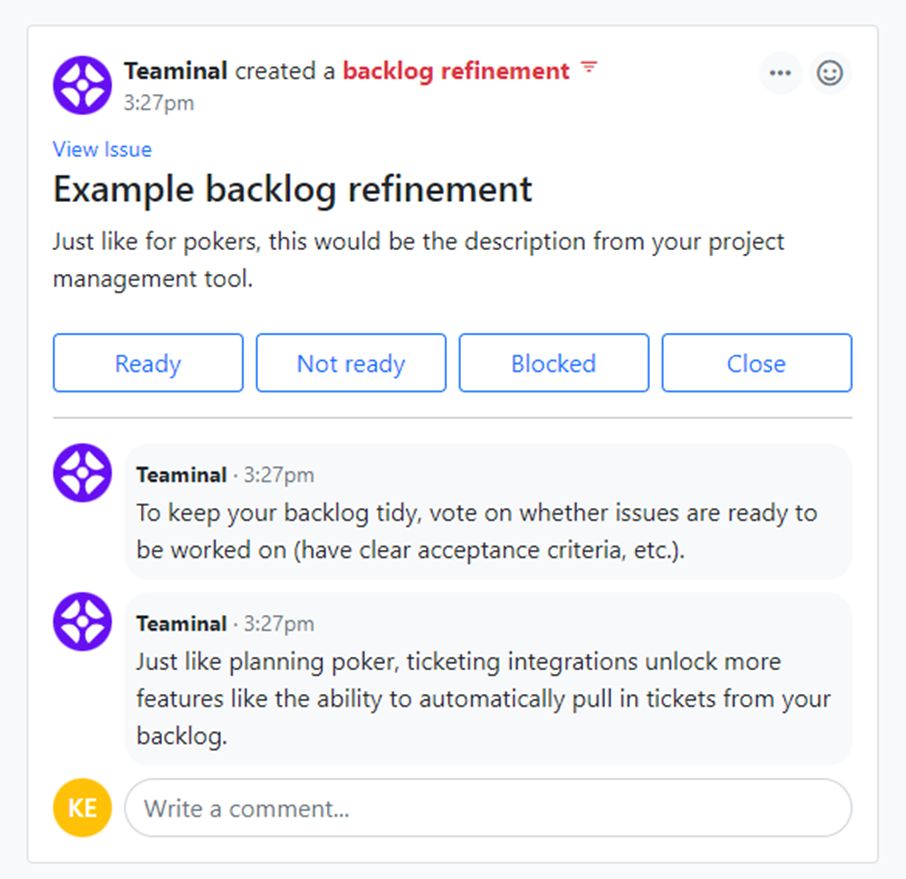
- Review and definition: Teaminal then gives your team a convenient place to define each backlog item with a priority, user story, and acceptance criteria. All comments are organized in threads, and voting is as simple as clicking a button.
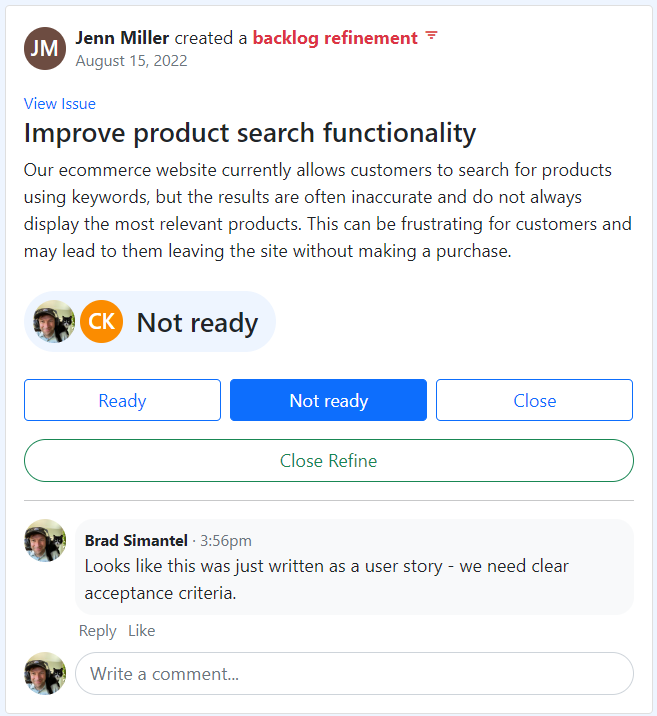
- Voting and shaping: Teaminal then allows your team to estimate story points using our async Slack planning poker feature (more on that later). These are pushed to Jira once voting is complete, so you can easily track the progress of each item.

Running backlog refinement ceremonies this way not only saves time, but also allows everyone on the team to have a voice in shaping the project’s direction.
Teaminal also ensures that the entire discussion is saved (in comment threads, on Slack, and on Jira) so that no important information is lost. Employees can come back at any time to refer to previous discussions and decisions, ask clarifying questions, and stay aligned with the project goals.
2. Sprint planning
Sprint planning is the ceremony where backlog items are scheduled for the upcoming sprint.
Many teams spend hours (sometimes up to 8) planning each sprint in long, all-hands meetings. The reason it takes so long is that many teams are operating with a relatively un-groomed backlog—if you follow the process above, you won’t have that issue.
Our optimized sprint planning meetings usually take 5–15 minutes. The PM pulls in high-priority items, checks to make sure that they’re well-defined and shaped, and then assigns them to team members.
And if they aren’t well-defined or shaped? We recommend running another poker planning session:
- Create a Poker: Start by creating a new planning poker session in Teaminal. You can do this by clicking on “Planning Poker” in the app or through Slack.
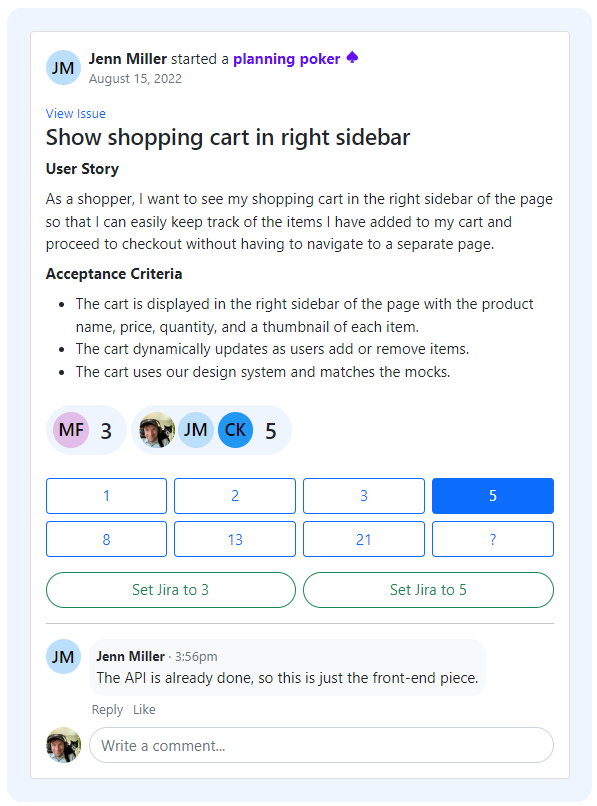
-
Invite team members: Invite your team members to join the planning poker session. Teaminal allows you to invite team members through email or by sharing a unique session link.
-
Discuss and vote: During the planning poker session, team members will discuss the high-priority items and then vote on their complexity. This allows for more accurate estimation and avoids bias towards round numbers.
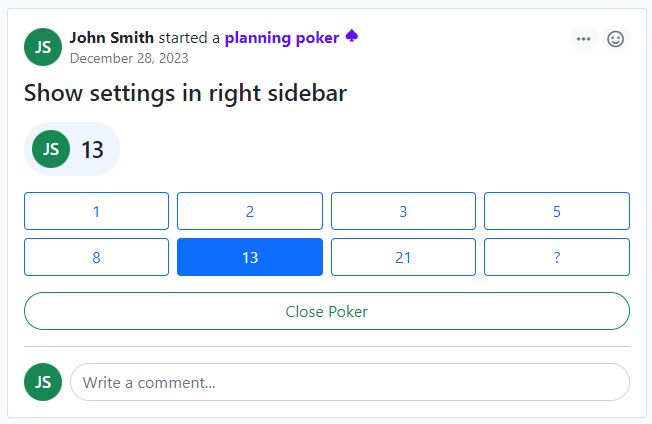
- Push points to Jira: Once the team has completed voting and reached a consensus, you can easily push the story points to Jira with just one click. This integration streamlines the process of updating your project management software.
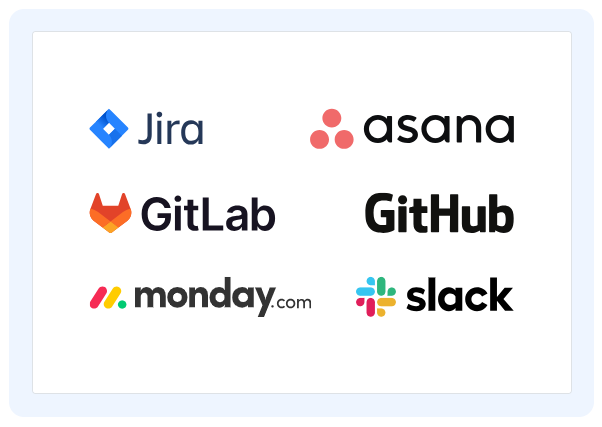
This process is usually quick and painless. The key is a well-groomed backlog that’s essentially ready to be worked on at any moment.
3. Daily standups
Daily standups are usually brief, 15-minute meetings where the development team synchronizes their activities and devises a plan for the next 24 hours.
This is an important part of Agile methodology—but the costs of scheduling face-to-face meetings (especially for international teams) often outweigh the benefits. That’s why Teaminal makes daily standups entirely async.
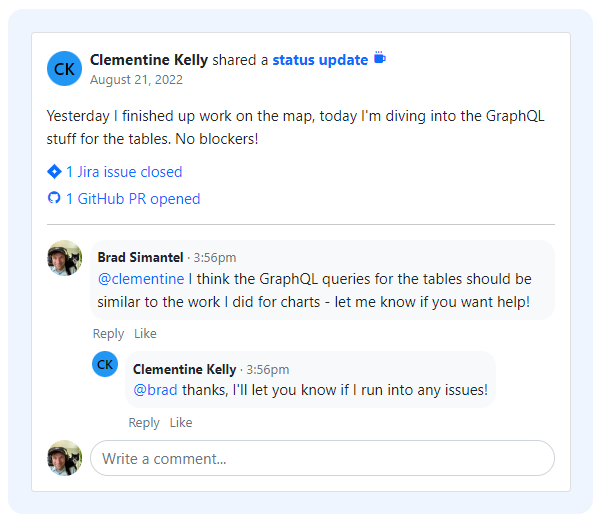
The process works by prompting developers via Slack when they first log in for the day (at whatever time is most convenient for them). They then respond to a set of questions about their progress, blockers, and plans for the day. Work completed or started in the last 24 hours is automatically pulled in from integrated tools to enrich each update.
This information is automatically compiled and shared with the rest of the team.
4. Sprint reviews and retrospectives
While sprint reviews and retros are different, we feel they can easily be combined into one, streamlined ceremony (that’s our first optimization). Our second optimization is making the entire process async and Slack-based for maximum flexibility.
During the combined sprint review and retrospective, the team will discuss what was completed during the sprint, any issues or blockers that arose, and what could be improved for future sprints. By combining these two ceremonies, teams can save time and have more focused discussions.
Teaminal helps with these discussions by generating summaries of:
-
Jira issues closed
-
GitHub PRs opened
-
Action items raised
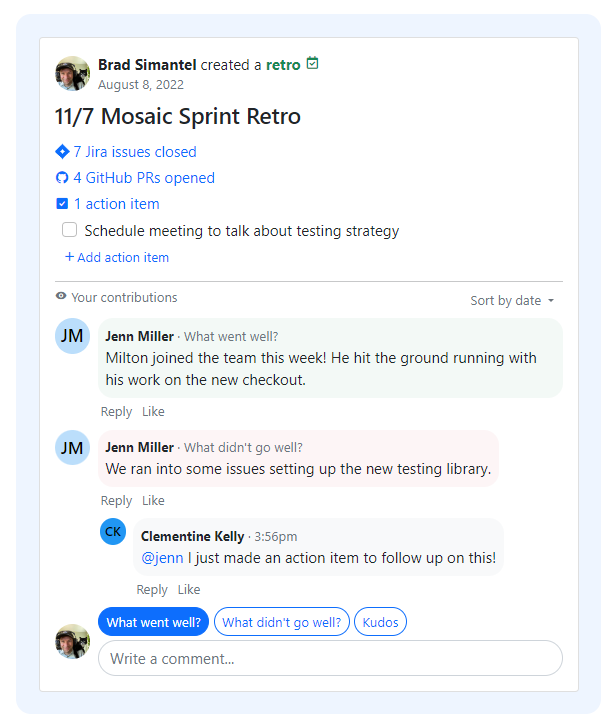
Team members are also given customizable prompts to respond to—things like “kudos” to give shoutouts to teammates, or “what didn’t go well?” to share any difficulties encountered during the sprint.
You can also use Teaminal’s reports on team sentiment and engagement to get a better understanding of your team’s overall well-being and collaboration. This can help identify any areas that may need improvement or highlight the team’s strengths.
Conclusion
While Scrum ceremonies are indispensable for fostering effective collaboration, delivering value, and ensuring continuous improvement in Agile teams, they run the risk of becoming tedious and unproductive without proper optimization.
At Teaminal, we’ve optimized the Scrum ceremonies to make them more efficient, engaging, and outcome-driven. With our platform, distributed teams can reap the benefits of Scrum ceremonies without being limited by time and location constraints
Try Teaminal today and see how it can elevate your Agile team’s productivity.




